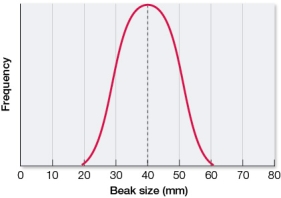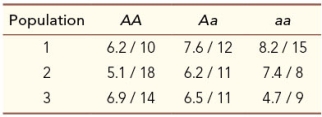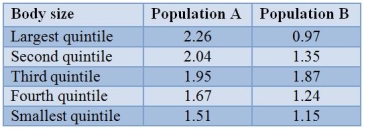A) It is sequestered in the skin of rough-skinned newts.
B) It paralyzes nerves and muscles by interfering with glycolysis.
C) It is an example of an adaptation.
D) It is an example of a chemical defense.
E) Some newts sequester the compound.
Correct Answer

verified
Correct Answer
verified
Essay
Draw the relationship between frequency of an allele (from 0.1 to 0.5) and its fitness in cases where frequency-dependent selection maintains genetic variation.
Correct Answer

verified
Correct Answer
verified
Essay
Refer to the graph showing beak size for a population of a species of Darwin's finches.  Draw a graph showing what the resulting population would most likely look like after a generation of directional selection for smaller beak size.
Draw a graph showing what the resulting population would most likely look like after a generation of directional selection for smaller beak size.
Correct Answer

verified
Correct Answer
verified
Multiple Choice
A benefit of sexual reproduction over asexual reproduction is that sexual reproduction
A) generates new combinations of alleles upon which selection can act.
B) breaks up adaptive combinations of genes.
C) produces offspring of two different genders, thus increasing the overall reproductive rate.
D) promotes Muller's ratchet.
E) increases the rate at which females can pass genes on to their offspring.
Correct Answer

verified
Correct Answer
verified
Multiple Choice
A windstorm transports a gravid fly to an island.Having only a small subset of the genetic variation in the mainland population, the offspring of this fly are somewhat different from the mainland population.This is an example of
A) Muller's ratchet.
B) purifying selection.
C) gene flow.
D) founder effect.
E) gene pooling.
Correct Answer

verified
Correct Answer
verified
Multiple Choice
Which phrase best describes natural selection?
A) The differential survival and reproduction of individuals
B) Chance variations in traits
C) The processes that lead individuals to resemble their parents
D) The potential for all species to increase rapidly in number
E) Individuals evolving in response to environmental change
Correct Answer

verified
Correct Answer
verified
Multiple Choice
Suppose variants at a single locus affect wing length in a species of crickets, with homozygotes for the L allele having long wings, homozygotes for the l allele having short wings, and heterozygotes having wings of intermediate length.In one population of 600 individuals, 400 have long wings, 160 have intermediate-lengths wings, and 40 have short wings.What is the expected number of individuals with long wings under Hardy-Weinberg equilibrium?
A) 216
B) 300
C) 384
D) 400
E) 480
Correct Answer

verified
Correct Answer
verified
Multiple Choice
The haploid human genome contains about 3 billion bp.Given a mutation rate of 5 × 10-9, how many new mutations would we expect on average in each diploid individual?
A) 1
B) 3
C) 15
D) 30
E) 60
Correct Answer

verified
Correct Answer
verified
Multiple Choice
The FY3 gene plays a role in immune responses in flies.In one population, there are two alleles, and the frequency of one allele is 0.8.If the population is at Hardy-Weinberg equilibrium, how many homozygotes for the more common allele should we observe in a sample of 250 individuals?
A) 10
B) 40
C) 80
D) 120
E) 160
Correct Answer

verified
Correct Answer
verified
Multiple Choice
The horn sizes in males of a particular beetle have an interesting distribution: the highest frequencies are around 15 millimeters and 30 millimeters, with few individuals in between.Based on this observation, which mode of selection is most likely to be operating on these horns?
A) Stabilizing selection
B) Directional selection
C) Concentrated selection
D) Disruptive selection
E) Purifying selection
Correct Answer

verified
Correct Answer
verified
Multiple Choice
Females preferring male bowerbirds with large bowers is an example of _______ selection.
A) purifying
B) stabilizing
C) disruptive
D) intrasexual
E) intersexual
Correct Answer

verified
Correct Answer
verified
Multiple Choice
The artificial selection experiments with bristle numbers in Drosophila illustrated which generality?
A) In such experiments, it is difficult to obtain individuals with traits that fall outside the range found in the original population.
B) Populations often contain considerable genetic variation upon which selection can operate.
C) Such experiments usually take thousands of generations to achieve their results.
D) Mutations occur to suit the needs of the population.
E) New species can be created via artificial selection.
Correct Answer

verified
Correct Answer
verified
Multiple Choice
The table shows the average performance of different genotypes at the A locus for three different populations of lizards in two different environments.The number before the slash is for running speed (in meters per second) , and the number after the slash is for relative strength.  In which population is there evidence of a trade-off between running speed and relative strength?
In which population is there evidence of a trade-off between running speed and relative strength?
A) Population 1 only
B) Population 2 only
C) Population 3 only
D) Both populations 1 and 2
E) Both populations 1 and 3
Correct Answer

verified
Correct Answer
verified
Multiple Choice
Which statement about neutral alleles is false?
A) Their frequencies are unaffected by natural selection.
B) Their frequencies can be affected by genetic drift.
C) They do not affect the fitness of their bearers.
D) Their frequencies will change only in very small populations.
E) They can be added to the population via mutation.
Correct Answer

verified
Correct Answer
verified
Multiple Choice
Whether a fly has white or red eyes is due to alleles at a single locus.It is thus a _______ or _______ trait.
A) quantitative; discrete
B) quantitative; continuous
C) qualitative; discrete
D) qualitative; continuous
E) heritable; continuous
Correct Answer

verified
Correct Answer
verified
Short Answer
The genome of a virus with 9,000 nucleotides has had 18 new mutations.The mutation rate is thus _______ percent.
Correct Answer

verified
Correct Answer
verified
Multiple Choice
The numbers of fledged young of female swamp sparrows of different sizes were assayed and are presented in the table.  Assume that body size is at least partially heritable.What is the most likely response to selection in population A?
Assume that body size is at least partially heritable.What is the most likely response to selection in population A?
A) Body size would increase.
B) Body size would decrease.
C) Body size would stay more or less the same, but the variance would increase.
D) Body size would stay more or less the same, but the variance would decrease.
E) None of the above; there is no selection occuring.
Correct Answer

verified
Correct Answer
verified
Multiple Choice
Which explanation has not been proposed for the existence of sexual reproduction?
A) Sexual reproduction facilitates repair of damaged DNA.
B) Sexual reproduction promotes the elimination of deleterious mutations.
C) Sexual reproduction accelerates Muller's ratchet.
D) Sexual reproduction creates a great diversity of genetic combinations that allows populations to adapt to the presence of pathogens.
E) Sexual reproduction maintains genetic variation.
Correct Answer

verified
Correct Answer
verified
Multiple Choice
Male mallards fighting with one another for access to females is an example of _______ selection.
A) purifying
B) stabilizing
C) disruptive
D) intrasexual
E) intersexual
Correct Answer

verified
Correct Answer
verified
Multiple Choice
The average size of downy woodpeckers in North America gradually increases as one moves north.What term best describes this phenomenon?
A) Directional selection
B) Frequency-dependent selection
C) Muller's ratchet
D) Clinal variation
E) Genetic drift
Correct Answer

verified
Correct Answer
verified
Showing 161 - 180 of 243
Related Exams